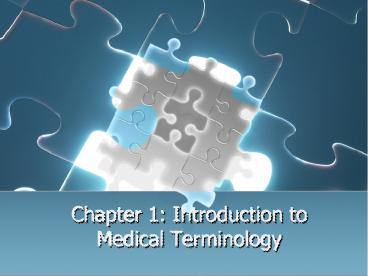Chapter 1: Introduction to Medical Terminology - PowerPoint PPT Presentation
Title:
Chapter 1: Introduction to Medical Terminology
Description:
Title: Chapter 7 Body Systems Author: Linda Honeycutt Last modified by: Fischer, Stacie L Created Date: 1/16/2005 5:28:53 PM Document presentation format – PowerPoint PPT presentation
Number of Views:146
Avg rating:3.0/5.0
Title: Chapter 1: Introduction to Medical Terminology
1
Chapter 1 Introduction to Medical Terminology
2
MEDICAL TERMINOLOGY
- The process of dividing medical words into
component parts. - Analysis of words will make medical terminology
easier to understand
and remember.
3
ORIGINS
- Word parts generally come from two language
origins - Greek
- Latin
4
5 BASIC WORD PARTS
- Root word
- Suffix
- Prefixes
- Combining vowel
- Combining form
5
ROOT WORD
- Root Word foundation of the word, usually
indicates the involved body part - Examples
- cardi - ?
- cephal
- gastr
- cyt
- A medical term can have one or more root words.
- Ex. cardi/o/thorac/ic pertaining to heart and
chest
6
SUFFIXES
- Word ending usually indicates a procedure,
condition, disorder or disease. - Read from the suffix backwards to the root word
for the correct meaning. - Suffixes can be nouns or adjectives
- All medical words have suffixes
- Examples
- -itis -ic
- -logy -lysis
7
PREFIXES
- Word beginning usually indicates location, time,
or a number - Not all medical words have prefixes
- Examples
- a-
- pre-
- hyper-
- sub-
8
COMBINING VOWELS AND FORMS
- Combining Vowel
- A vowel that links two word parts together
- Usually an o
- Has no meaning of its own
- Combining Form root word plus a combining vowel
- Examples
- Hemat/o
- Cardi/o
- Gastr/o
- Oste/o
9
RULES FOR USING COMBINING VOWELS
- When the ending of the root word and the
beginning of the suffix are both consonants, use
a combining vowel. - Example hemat/o/logy
- When the ending of the root word is a consonant,
and the beginning of the suffix is a vowel, do
not use a combining vowel. - Example gastr/itis
10
RULES FOR USING COMBINING VOWELS
- 3. A combining vowel is always used when two root
words are joined. - Example cardi/o/thorac/ic
- 4. A prefix does not require a combining
- vowel
- Example epi/gastr/ic
11
TAKING TERMS APART
- Determine a medical words meaning by looking at
the component pieces. - Start at the suffix (all medical terms will have
one) - Identify if there is a prefix (not all medical
terms will have one) - Locate the root words (there may be more than
one) - Identify the meaning of each word part as you
separate them
12
TAKING TERMS APART
- Remember!
- If you have any doubt about the correct meaning
of a word, use a medical dictionary (appendix,
internet) to double check the definition.
13
SPELLLING
- In medicine, spelling is critical!!!
- One wrong letter could mean an entirely different
place on the body or test to be performed - Examples ilium and ileum, PAC and PVC, etc
14
TIME TO PRACTICE!!!
- In order to break words into their component
parts, you will need to become familiar with
Appendix A in your textbook (starting on page
293). - Write the following words on your paper leaving 4
spaces between words - Endocardium
- Pneumonia
- Using the appendix, break each word into word
parts by placing a line in between the breaks (a
/ pnea) - Then, define the meaning of each word part by
using the definition in the appendix (a no,
not, without and -pnea breathing) - Finally, write the definition of each medical
word (apnea without breathing or no breathing)
- Hyperthermia
- Gastroenteritis































